
Facility Management Software: Top Solutions for 2025
In ultra-modern, rapid-paced business surroundings, handling facilities correctly is critical for companies of all sizes. From business buildings and workplaces to academic establishments and healthcare facilities, powerful facility management ensures the most fulfilling aid usage, fee savings, and an efficient operating environment. Facility management software programs have emerged as an effective tool to streamline operations, enhance productivity, and make records-pushed selections. As we technique 2025, the call for sturdy and progressive facility management answers continues to rise, reflecting current centers’ growing complexity and evolving desires.
What is Facility Management Software?
A complete technological solution for managing and optimizing many areas of facility operations is facility management software. It offers a consolidated platform for managing space usage, keeping track of maintenance tasks, monitoring and controlling building systems, and guaranteeing adherence to safety and legal requirements. This program allows facility managers to better serve residents and guests by streamlining operations, increasing productivity, and integrating a variety of facility-related procedures and data.
Importance of Facility Management Software
Organizations need effective facilities management to meet their operating objectives and stay competitive. Software for facility management is essential for tackling the following issues:
Enhanced Operational Efficiency
- Automates routine tasks like maintenance scheduling and work order management.
- Reduces human error and optimizes resource allocation.
Cost Savings
- Identifies inefficiencies and areas for cost reduction.
- Tracks energy usage to highlight conservation opportunities.
- Prevents costly breakdowns with regular maintenance schedules.
Improved Asset Management
- Tracks asset lifecycles, maintenance history, and depreciation.
- Ensures proper maintenance, reducing downtime and preventing failures.
Regulatory Compliance
- Keeps detailed records and schedules necessary inspections.
- Ensures adherence to safety, health, and environmental standards.
- Minimizes legal penalties and enhances workplace safety.
Data-Driven Decision Making
- Gathers and analyzes data on facility operations.
- Enables informed decision-making and strategic investments.
- Identifies trends and forecasts future needs.
Enhanced Communication and Collaboration
- Centralizes information sharing and task tracking.
- Improves coordination and ensures team members are aligned.
- Leads to more efficient operations.
Space Optimization
- Provides insights into space utilization.
- It helps optimize the layout and use of available space.
- Leads to cost savings and improved productivity.
Scalability and Flexibility
- scalable to accommodate expanding businesses’ needs.
- Customizable to specific organizational requirements.
- Supports expansion without a decline in performance.
Sustainability Initiatives
- Monitors and reduces energy consumption.
- Manages waste and implements eco-friendly practices.
- It improves the company’s reputation and may result in financial savings.
Improved Tenant and Employee Satisfaction
- Ensures facilities are well-maintained, safe, and comfortable.
- Quick responses to maintenance requests.
- Contributes to higher tenant retention and employee productivity.
Benefits of Facility Management Software
Implementing a robust facility management software solution offers numerous benefits to organizations:
Improved Operational Efficiency:
Automated processes, centralized data management, and real-time monitoring enhance operational efficiency and productivity.
Cost Savings:
Optimizing resource utilization, streamlining maintenance activities, and minimizing energy consumption help achieve significant cost savings.
Enhanced Asset Management:
Comprehensive asset tracking, preventive maintenance scheduling, and lifecycle management ensure optimal asset performance and longevity.
Increased Space Utilization:
Space planning and allocation tools maximize available space usage, reducing overhead costs and improving occupant satisfaction.
Regulatory Compliance:
Built-in compliance management features assist in adhering to safety regulations, environmental standards, and industry-specific guidelines.
Data-Driven Decision Making:
Sturdy reporting and analytics tools offer insightful information for strategic planning and well-informed decision-making.
Key Features of Facility Management Software
Asset and Inventory Management:
- Maintain and track tangible assets, including infrastructure, furnishings, machinery, and buildings.
- Utilize barcode or RFID tagging for efficient asset identification and tracking.
- Monitor asset depreciation and lifecycle to plan for replacements and upgrades.
Maintenance Management:
- Schedule and track preventive and corrective maintenance activities, work orders, and service requests.
- Generate automated maintenance schedules based on asset usage and condition.
- Maintain detailed maintenance logs for regulatory compliance and audit purposes.
Space Management:
- Optimize space utilization with space planning, allocation, and move management capabilities.
- Visualize floor plans to identify underutilized areas and plan space reconfigurations.
- Integrate with workplace management systems to accommodate flexible work arrangements.
Energy and Sustainability Management:
- Monitor energy consumption, implement sustainability initiatives, and ensure environmental compliance.
- Examine trends in energy consumption to find areas where efficiency might be increased.
- Track carbon emissions and waste management to support corporate sustainability goals.
Building Automation Integration:
- Integrate with building automation systems (BAS) and IoT devices for real-time monitoring and control.
- Implement predictive maintenance algorithms to identify equipment failures before they occur.
- Automate HVAC and lighting systems based on occupancy and environmental conditions.
Visitor and Contractor Management:
- Manage visitor and contractor access, check-in/check-out processes, and security protocols.
- Issue temporary access badges or digital credentials for streamlined visitor management.
- Conduct background checks and credential verification to ensure security compliance.
Mobile Capabilities:
- Access and update facility information on the go through mobile apps and responsive interfaces.
- Capture and upload photos, videos, and notes directly from mobile devices for documentation.
- Receive real-time notifications and alerts for critical issues or maintenance updates.
Reporting and Analytics:
- Generate customizable reports, dashboards, and analytics for data-driven decision-making.
- Analyze historical maintenance data to identify trends and predict future maintenance needs.
- Benchmark facility performance against industry standards and KPIs to drive continuous improvement.
Types of Facility Management Software
Various facility management software solutions can be distinguished by their deployment methodologies and intended user base.
Cloud-based Facility Management Software:
- Offered as a software-as-a-service (SaaS) solution.
- Allows access from any device with an internet connection.
- Enables remote management and collaboration among dispersed teams.
On-premises Facility Management Software:
- It is installed and hosted on an organization’s local servers and infrastructure.
- Provides full control over data security and customization.
- Requires dedicated IT resources for maintenance and updates.
Integrated Workplace Management System (IWMS):
- Combines facility management with other workplace services.
- Includes features for real estate portfolio management and project management.
- Provides a holistic view of the entire workplace environment and operations.
Computer-Aided Facility Management (CAFM):
- Specialized software integrating computer-aided design (CAD) and building information modeling (BIM) capabilities.
- Facilitates facility planning, design, and management.
- Enables visualization of facilities in 2D and 3D for improved decision-making.
Best Facility Management Software
Selecting a satisfactory facilities control software program bundle could be challenging, given the abundance of options in the marketplace. The following are the various best facility management software program options for 2025 to take into account:
IBM TRIRIGA
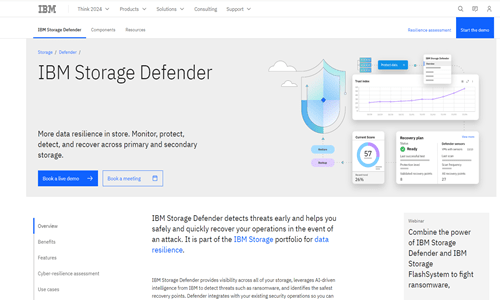
An integrated workspace management system (IWMS) called IBM TRIRIGA aids in optimizing real estate and facility management.
Pros:
Comprehensive IWMS solution with powerful analytics capabilities.
Cons:
The steeper learning curve and higher implementation costs.
Services:
- Real estate management
- Capital project management
- Space management
Pricing package:
Contact IBM for pricing details.
Archibus.
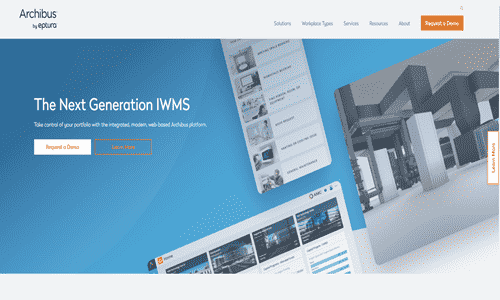
Archibus is a leading cloud-based facility management software provider that offers space optimization and asset management solutions.
Pros:
User-friendly interface with robust reporting capabilities.
Cons:
Limited customization options may require additional modules for advanced features.
Services:
- Space planning and management
- Asset lifecycle management
- Maintenance management
Pricing package:
Contact Archibus for pricing details.
iOffice
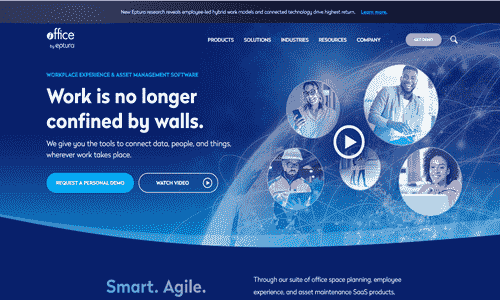
iOffice is a cloud-based facility management software that focuses on improving workplace experience and efficiency.
Pros:
Intuitive interface, customizable dashboards.
Cons:
Integration with third-party systems can be challenging, with limited mobile functionality.
Services:
- Space utilization tracking
- Service request management
- Employee engagement tools
Pricing package:
Contact iOffice for pricing details.
Nuvolo
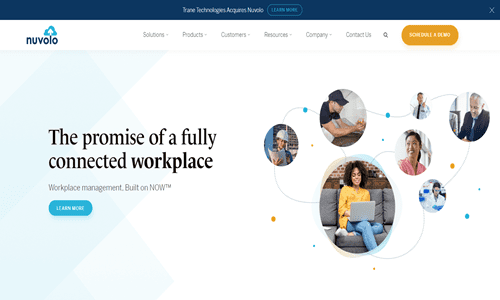
Nuvolo offers a cloud-based platform for enterprise asset management, including facilities and workplace management solutions.
Pros:
Scalable solution, strong mobile capabilities.
Cons:
Complexity may require dedicated training and higher subscription costs.
Services:
- Asset tracking and management
- Preventive maintenance scheduling
- Compliance management
Pricing package:
Contact Nuvolo for pricing details.
UpKeep
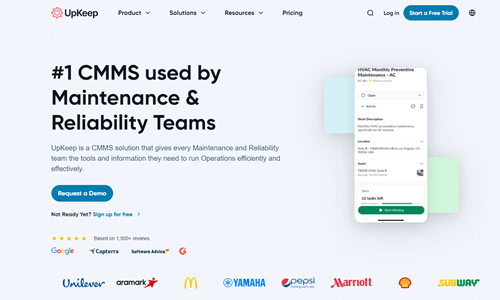
UpKeep is a mobile-first maintenance management software designed for facility and asset management.
Pros:
Easy-to-use mobile app with affordable pricing plans.
Cons:
Lack of advanced features compared to enterprise solutions limited reporting options.
Services:
- Work order management
- Asset tracking
- Inventory management
The package provides various pricing options, with premium subscriptions available for more functionality and basic features starting at free.
FMX
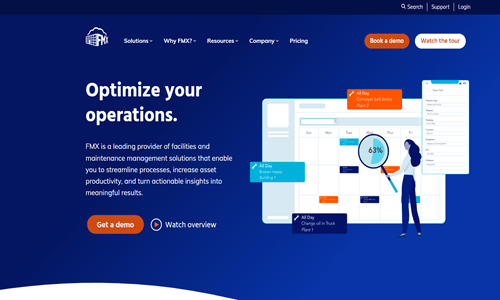
FMX is a cloud-based facilities management platform that simplifies work order management and maintenance tracking.
Pros:
Intuitive user interface, customizable workflows.
Cons:
Limited integrations with other systems’ basic reporting capabilities.
Services:
- Work order management
- Asset tracking
- Preventive maintenance scheduling
Pricing package:
Contact FMX for pricing details.
ServiceNow Facility Management
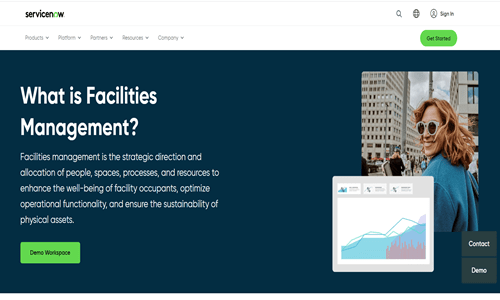
ServiceNow offers a comprehensive platform for facility management, including service request management and asset tracking.
Pros:
Integration with other ServiceNow modules extensive automation capabilities.
Cons:
High initial setup costs may require specialized training for full utilization.
Services:
- Service request management
- Asset and inventory management
- Space planning and optimization
Pricing package:
Contact ServiceNow for pricing details.
Planon
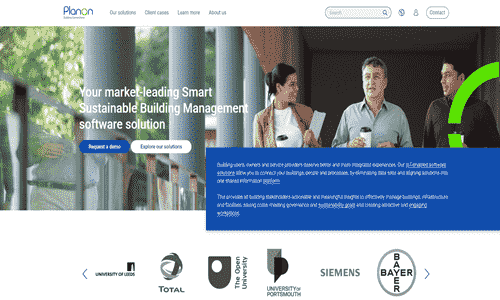
Planon provides an integrated workplace management system (IWMS) for real estate, space, and asset management.
Pros:
Comprehensive IWMS solution, strong customer support.
Cons:
The complex implementation process requires a higher initial investment.
Services:
- Real estate management
- Space optimization
- Asset lifecycle management
Pricing package:
Contact Planon for pricing details.
MaintainX
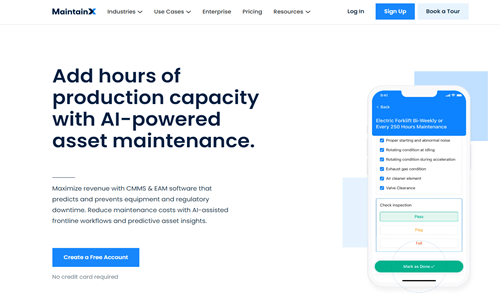
MaintainX is a mobile-first maintenance management software for facilities, manufacturing, and field service management.
Pros:
User-friendly mobile app with affordable pricing plans.
Cons:
Limited scalability for larger enterprises, basic reporting features.
Services:
- Work order management
- Asset tracking
- Task scheduling and assignment
Pricing package:
It offers more than a few pricing plans, starting from free for fundamental features and with top-rate plans for additional functionality.
Hippo CMMS
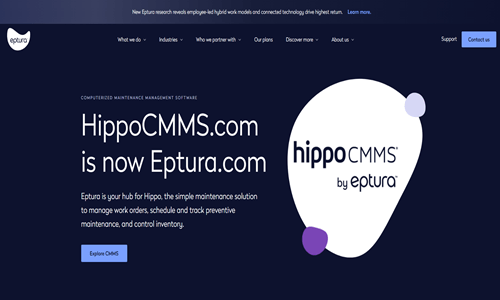
Hippo CMMS offers cloud-based maintenance management software for facility and asset management.
Pros:
User-friendly interface with customizable maintenance workflows.
Cons:
Limited mobile app functionality may need more advanced features for complex operations.
Services:
- Preventive maintenance scheduling
- Asset and equipment tracking
- Inventory management
Pricing package:
Contact Hippo CMMS for pricing details.
Implementation of Facility Management Software
A successful implementation of facility management software is vital for figuring out its complete ability and maximizing return on investment (ROI). The implementation method commonly involves the subsequent steps:
Requirements Gathering and Analysis:
- Outline your company’s precise facility control requirements, tactics, and goals to ensure the software program aligns with your needs.
- Conduct stakeholder interviews and workshops to gather diverse perspectives and insights into facility management needs.
Software Selection and Evaluation:
- Research and evaluate facility management software solutions based on features, scalability, integration capabilities, and vendor support.
- Consider conducting an evidence of concept (percent) or pilot project to assess the software’s capability and suitability for your company’s needs.
Implementation Planning:
- Develop a detailed implementation plan, including project timelines, resource allocation, and change management strategies.
- Discover key milestones and dependencies to track progress and ensure timely crowning glory of the implementation manner.
Data Migration and Integration:
- Transfer existing facility data, asset information, and maintenance records into the new system.
- Develop data mapping and cleansing strategies to ensure data accuracy and integrity during migration.
User Training and Adoption:
- Provide complete education to facility managers, technicians, and other stakeholders to ensure effective use of the software’s features and capabilities.
- Offer refresher training sessions and user guides to support ongoing learning and adoption of the software.
Testing and Validation:
- Conduct thorough testing to ensure the facility management software functions correctly and meets operational requirements.
- Involve end-users in user acceptance testing (UAT) to validate the software’s functionality and gather feedback for improvement.
Go-Live and Support:
- Launch the facility management software, with ongoing support and maintenance from the vendor or in-house IT team, to address issues and optimize performance.
- Establish a dedicated support team or helpdesk to provide timely assistance and troubleshoot any technical issues users encounter.
Common Challenges in Facility Management Software
While facility management software offers numerous benefits, organizations may face several challenges during implementation and adoption:
Data Great and Integration:
- Ensuring correct and constant information from numerous resources and integrating the power control software with present structures can be complex.
- Data cleansing and normalization may be necessary to address discrepancies and ensure data integrity across platforms.
User Adoption and Training:
- Ensuring personal adoption and supplying adequate schooling for facility managers, technicians, and other stakeholders is quintessential for a successful implementation.
- Resistance to change and lack of familiarity with the new software interface can hinder adoption, emphasizing the importance of comprehensive training programs.
Change Management:
- Implementing facility management software often requires changes in processes, workflows, and employee responsibilities, necessitating effective change management strategies.
- Clear communication, stakeholder engagement, and leadership support are essential to mitigate resistance and facilitate smooth transitions.
Customization and Configuration:
- Configuring the software program to align with precise enterprise strategies and necessities requires enormous effort and knowledge.
- Balancing the want for customization with retaining device simplicity and scalability is crucial to keep the software program architecture manageable.
Budget and Resource Constraints:
- Implementing and maintaining facility management software can be a significant investment, requiring adequate budgeting and resource allocation.
- Limited financial resources and competing priorities make securing the necessary funding and staffing for successful software implementation and ongoing support challenging.
Trends in Facility Management Software
The power management software industry is constantly evolving and driven by technological improvements and converting business wishes. Here are some high-quality tendencies to observe for 2025:
Internet of Things (IoT) Integration:
- Facility management software will increasingly integrate with IoT devices and sensors for real-time monitoring, predictive maintenance, and automated building control.
- IoT data will be utilized to optimize energy usage, improve asset performance, and enhance occupant comfort and safety.
Artificial Intelligence (AI) and Machine Learning (ML):
- AI and ML will be leveraged for predictive analytics, automated decision-making, and optimized resource allocation.
- Predictive maintenance algorithms will help identify potential equipment failures before they occur, reducing downtime and maintenance costs.
Building Information Modeling (BIM) Integration:
- Integration with BIM models will enhance facility planning, design, and construction, enabling better collaboration and data exchange.
- BIM data will facilitate more accurate asset management, space utilization planning, and renovation projects.
Mobile and Augmented Reality (AR) Capabilities:
- Mobile apps and AR technologies will improve field service operations, asset management, and remote assistance capabilities.
- Technicians can use AR-enabled devices to access real-time equipment data, view maintenance instructions, and receive hands-free repair guidance.
Cloud and SaaS Adoption:
- Cloud-based and Software-as-a-Service (SaaS) facility management solutions will continue to gain popularity, offering scalability, accessibility, and reduced IT overhead.
- Organizations will benefit from seamless updates, flexible pricing models, and access to software from any location with internet connectivity.
Sustainability and Energy Management:
- There has been an increased focus on sustainability and energy management features to support organizations’ environmental goals and comply with green building standards.
- Facility management software will provide tools for tracking energy usage, implementing conservation measures, and reporting sustainability metrics to stakeholders.
Cost Analysis of Facility Management Software
Implementing and maintaining facility management software involves various costs that organizations should consider:
Software Licensing or Subscription Fees:
- Facility management software can be licensed through perpetual licenses or subscription-based pricing models, with costs varying depending on the vendor, features, and deployment model.
- Subscription fees may include monthly or annual payments, while perpetual licenses involve upfront costs and potential renewal fees for maintenance and support.
Implementation and Customization Costs:
- The costs associated with configuring the software to align with your organization’s specific processes, integrating with existing systems, and making any required customizations.
- Implementation services supplied by the seller or third-birthday party consultants may additionally incur additional prices based on the complexity of the challenge.
Hardware and Infrastructure Costs:
- If deploying an on-premises facility management solution, there may be costs related to purchasing or upgrading server hardware, storage, and network infrastructure.
- Cloud-based solutions alleviate some hardware costs but require sufficient internet bandwidth and infrastructure for reliable access.
Training and Change Management Costs:
- Expenses related to training facility managers, technicians, and other stakeholders, managing organizational change and ensuring user adoption of the new software.
- Training programs may include instructor-led sessions, online courses, documentation, and ongoing support resources to facilitate the software’s effective utilization.
Data Migration and Integration Costs:
- Costs involved migrating existing facility data, integrating with other systems (such as BAS, ERP, or CMMS), and ensuring data quality and integrity.
- Records migration offerings may also require data cleaning, mapping, and validation to ensure a smooth transition, except for records loss or corruption.
Ongoing Maintenance and Support Costs:
- Recurring costs for software updates, technical support, and maintenance from the facility management software vendor or in-house IT resources.
- Maintenance fees may be included in subscription plans or billed separately based on the level of support and service agreements.
Additional Modules or Add-ons:
- Some facility management software vendors offer additional modules or add-ons for specific functionality, such as space planning, energy management, or mobile applications, which may incur extra costs.
- Organizations should evaluate the necessity and cost-effectiveness of these additional features based on their specific requirements and budget constraints.
Future of Facility Management Software
The destiny of facility management software programs is closely tied to technological improvements and evolving organizational desires. As we look beforehand to 2025 and beyond, numerous traits and trends are predicted to structure the industry:
Increased Adoption of Cloud and SaaS Solutions:
- Cloud-based and Software-as-a-Service (SaaS) facility management solutions will continue to gain momentum, offering scalability, accessibility, and reduced IT overhead.
- Organizations will benefit from the flexibility of cloud-based solutions, enabling remote access and seamless updates without the need for on-premises infrastructure.
Integration with Emerging Technologies:
- Facility management software will increasingly integrate with emerging technology consisting of artificial talent (AI), device getting to know (ML), internet of things (IoT), and augmented reality (AR) to decorate automation, predictive analytics, and far-off operations.
- AI and ML algorithms will analyze facility data to optimize maintenance schedules, predict equipment failures, and improve operational efficiency.
Sustainability and Energy Management:
- With growing environmental concerns, facility management software will prioritize sustainability features, enabling organizations to monitor and optimize energy consumption, implement green initiatives, and comply with environmental regulations.
- Superior energy management equipment will offer insights into energy usage patterns, pick out regions for improvement, and track progress toward sustainability dreams.
Mobile and Collaborative Capabilities:
- Mobile apps and collaborative features will become essential for enabling remote access, real-time updates, and seamless communication between facility managers, technicians, and stakeholders.
- Mobile-enabled workflows will streamline work order management, asset inspections, and maintenance tasks, improving productivity and response times.
Predictive Maintenance and Asset Management:
- Advanced analytics and predictive maintenance capabilities will be integrated into facility management software, enabling proactive asset management and minimizing unplanned downtime.
- Predictive algorithms will analyze device overall performance facts to identify capacity disasters before they arise, considering timely preservation interventions and stepped-forward asset reliability.
Integration with Building Information Modeling (BIM):
- Closer integration with BIM models will enhance facility planning, design, and construction, enabling better collaboration and data exchange throughout the building lifecycle.
- BIM data will provide a comprehensive digital representation of facilities, supporting informed decision-making, accurate asset management, and efficient space utilization.
Frequently Asked Questions
Is facility management software appropriate for small organizations or just for large companies?
Facility management software is designed to benefit organizations of all sizes, from small businesses to large enterprises. Many vendors offer scalable solutions tailored to different organization sizes’ specific needs and budgets.
Can facility management software integrate with existing building automation systems (BAS) and IoT devices?
Modern facility management software solutions are designed to integrate with various BAS, IoT devices, and sensors, enabling real-time monitoring, control, and data exchange.
How long does it typically take to implement facility management software?
The implementation timeline can vary depending on the complexity of your corporation’s facility control procedures, the software chosen, and the extent of customization required. Normally, implementation can take several weeks to numerous months.
Is user training provided during the implementation of facility management software?
Authentic facility management software vendors normally offer complete personal education and guide offerings as part of the implementation method. This includes schooling for facility managers, technicians, and other stakeholders to make certain powerful usage of the software’s features and abilities.
Can facility management software be accessed and used on mobile devices?
Many facility management software solutions offer mobile apps and responsive interfaces, enabling facility managers and technicians to access and update information from their mobile devices.
Conclusion
In conclusion, facility management software has become an indispensable tool for modern organizations striving for operational efficiency and cost-effectiveness. This software significantly improves facilities’ overall functionality and productivity by streamlining maintenance processes, enhancing asset management, and facilitating real-time communication. As technology evolves, adopting a robust facility management software solution will be crucial for businesses to stay competitive and responsive to the dynamic demands of their operational environments. Embracing this technology simplifies facility management and fosters a more sustainable and well-maintained infrastructure, ultimately contributing to long-term success and growth.




